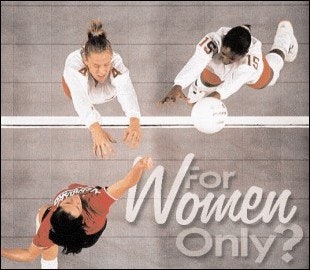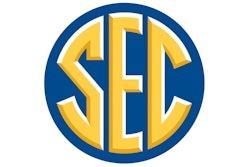Despite a surge in interest among males, gender balancing, funding shortfalls and institutional conservatism have kept volleyball largely a women's game. Welcome to what could be the next decade's battleground.

You want a Title IX success story? Try women's basketball. Starting from scratch, high schools and colleges added girls' and women's programs as a complement to their boys' and men's programs, and, taking advantage of a nationwide explosion in the popularity of basketball, watched the participation and spectator numbers grow. It was slow going - girls' high school tournaments in many states and women's collegiate hoops in many conferences were already viable enterprises before the marketers caught on. Once they did, though, the sport got a needed boost in advertising and licensing dollars, and in television visibility. Then, even further prestige arrived in the form of not one, but two women's pro leagues - the American Basketball League, which in March crowned its first champion, and the NBA-backed Women's National Basketball Association, which will begin play this June.
Women's volleyball has not been nearly as successful, but it has enjoyed a similar trend line. In an effort to respond to the interests and abilities of female student-athletes (as mandated by Title IX legislation), the number of high schools sponsoring girls' volleyball jumped from 1,550 in 1971-72 to 10,332 in just four years. More than 90 percent of NCAA-member institutions have sponsored women's intercollegiate volleyball since women's intercollegiate athletics came under the NCAA umbrella in 1981-82 from the Association of Intercollegiate Athletics for Women (AIAW). Participation and spectator totals have gained steadily, spurred by regular American successes in the Olympics and the increased interest in and television exposure given beach volleyball.
Take a bow, ladies - high fives all around. Now, what about the men?
It's been a very different story. High schools sponsoring boys' volleyball went into a freefall after the passage of Title IX, bottoming out at 393 schools in 1984-85. At the collegiate level, men's volleyball nearly lost tournament status by hitting the NCAA minimum of 50 institutions in 1986-87. Since that time, interest among males in volleyball has been on the rise, and the number of high school and college teams has risen along with interest.
But many men's volleyball enthusiasts charge that the increase has not been commensurate with men's interest or ability - language that should be instantly recognizable to anyone familiar with Title IX. The growth of men's volleyball, they say, has been stunted by a variety of factors, with gender balancing a prime culprit.
Bob Newcomb, director of the Center for Statistical Consulting at the University of California at Irvine and a former men's volleyball coach there, heads up a grant program overseen by the U.S. Volleyball Association that in recent years has helped grow men's collegiate volleyball. Although Newcomb applauds the success of women's volleyball - as a volleyball enthusiast he sees the women as "kindred" - he believes volleyball has a troublesome bottom line.
"Eight hundred and forty-seven NCAA members sponsor women's volleyball," he says. "Seventy-four sponsor men's. If that inequity were reversed, it would be a public cause."
Perhaps the situation is inequitable. But to women's advocates, the suggestion is tantamount to scapegoating women for the deep financial problems faced at all levels of education.
"I'm getting tired of hearing that Title IX is the problem," says Sandy Vivas, executive director of the Colorado Springs, Colo.-based American Volleyball Coaches Association (AVCA). "What the numbers tell me is that the issue isn't Title IX, it's dollars. If you have the dollars, people will add the sport."
Vivas points to two facts to back up her point: The loss of men's collegiate volleyball programs predates Title IX enforcement, and many men's sports have been gaining numbers in recent years despite gender balancing and the financial woes claimed by most institutions.
In the latter case, Vivas mentions men's collegiate baseball, whose advocates "have been very vocal about losing their programs," but actually gained 123 programs between 1988 and 1994. Yet, during those years, the NCAA itself grew by 105 institutions; the percentage of NCAA member schools sponsoring baseball held steady at 84 percent for most of that time. Since 1994, however, her point is well-taken. NCAA membership has been capped at just over 900, while the number sponsoring baseball programs has risen by 39 - from 87 to 92 percent of all member institutions. (As a percentage of NCAA schools, women's volleyball has risen steadily from 80 percent in 1981 to 90 percent in 1988 and 94 percent today.)
As to the initial decline of men's collegiate volleyball, the reasons are not entirely clear. "Men's volleyball lost the greatest numbers of programs from 1978 to 1988, when Title IX was not being enforced," Vivas says. In fact, the greatest loss occurred in the late 1970s.
According to Newcomb, "The numbers reflect NCAA legislation more than anything." That is, the number of men's teams initially rose when the association raised the minimum number of sports institutions had to offer to keep Division I status, and fell after that standard was lowered - and then, he says, "gender balancing set in. The combination really started this drift."
Whatever the reasons, the unassailable truth is that institutions at both the college and high school level have become increasingly cognizant of Title IX goals and requirements - and that, even beyond the issue of funding, the increased popularity of boys' and men's volleyball is problematic for them.
Boys' volleyball advocates in Michigan would not agree that Title IX is not part of the issue. There, in 1994, the Michigan High School Athletic Association's Representative Council defeated a motion that the MHSAA sponsor a boys' volleyball tournament, because the association had just added a girls' tournament that finally equalized the number of tournaments for boys and girls at 12 apiece.
"High schools are trying to accommodate both female and male participants," says Gina Mazzolini, an MHSAA assistant director. "It's an issue that locally people are struggling with."
A rash of volleyball-related lawsuits filed by boys in the last several years highlights the problem. Boys in various parts of the country asked their schools to sponsor a boys' volleyball team, only to be rebuffed - and then, seeing the schools accommodate girls' interests by allowing girls to wrestle or play football on boys' teams, asked the schools to let them play volleyball with the girls.
The reasons to prohibit this run from the philosophical - females are the historically underrepresented gender, not males - to the physiological. In each case, school administrators argued successfully that allowing boys to play on girls' teams would diminish athletic opportunities for girls. In addition, boys' natural athletic advantages would lead to injuries among female participants unless the net were raised from the girls' standard (7 feet, 4 1 / 8 inches) to the boys' standard (7 feet, 11 5 / 8 inches) - in essence altering the sport from one boy playing on a girls' team to 11 disadvantaged girls playing with one boy on a boys' court.
Several state high school associations subsequently promoted legislation to help foil the suits. In Wyoming, a Mixed Gender Participation Rule passed in 1994 put an end to all mixed-gender teams, whatever the situation. In Ohio, a rule was passed allowing girls on boys' teams when necessary, but barring boys from girls' teams in all circumstances.
Sonny Lewis, who coaches volleyball at Springfield High School in Holland, Ohio, and is a state director with the National Federation Interscholastic Coaches Association, says his state has about 70 boys' volleyball teams and hasn't been able to get those numbers to increase.
"Administrators don't want to add a team until Ohio recognizes boys' volleyball, and Ohio is not going to recognize boys' volleyball until schools get enough teams playing," he says. "We're running around in circles like a dog chasing its tail."
That sort of catch-22 is the reason Lewis agrees with Vivas that Title IX is more a convenient scapegoat than the root of the problem.
"Administrators don't want to start another team, and I don't think it's because of Title IX," Lewis says. "It's an added cost and another night they have to be there. A school's got one AD, maybe two, and with five sports going on at night it's hard to cover them all." (Finding this, Ohio volleyball coaches abandoned their gender-balancing idea of getting schools to add boys' volleyball as part of a package deal with girls' slow-pitch softball.)
A small group of Missouri high schools in 1995 managed to successfully lobby the Missouri State High School Activities Association to sanction boys' volleyball, previously a club sport, as a varsity sport, although they haven't yet managed to reach the minimum 50 teams required to gain tournament status. Just under 40 of the MSHSAA's 566 high schools begin their second season this spring, reports Stacy Schroeder, an MSHSAA assistant executive director, including a group of four in the Kansas City area that are having difficulty convincing other area schools to jump on the boys' volleyball bandwagon.
"Some are hurting for funds, whether you're talking about adding a boys' or girls' sport, but gender balancing is part of it," Schroeder says. "Even the schools that have added it have found that the Title IX issue hinders them in trying to get it through their board of education. Most schools offer wrestling and football and are out of compliance as it is. If they add boys' volleyball it's just going to push them further out of compliance. It really is a balancing act for ADs."
It may not be a surefire method of avoiding potentially damaging lawsuits, but several groups are trying to raise the funding necessary both to save non-revenue sports from the budgetary axe and men's non-revenue sports in particular from the gender-balancing axe.
Men's volleyball is classified by most observers (and more importantly, by the NCAA) as a non-revenue sport, much to the chagrin of people like Sandy Vivas and Bob Newcomb. Non-revenue in this context might merely mean "small," rather than refer specifically to its revenue-producing potential. As Vivas notes, the men's collegiate volleyball championship has been a moneymaker for the NCAA and for CBS, which airs the finals every May, and still has been close to the point of going under.
Perhaps non-revenue means "low budget." If so, Newcomb says, the appelation fits men's volleyball.
"If people did an objective business prospectus, I think they would be shocked at how good men's volleyball's impact-per-dollar is, and if they looked at growth in participation numbers at the high school level, they'd see a growing pool of youngsters who want to continue to play," he says. "It's low cost - if you offered just two scholarships, you'd be competitive with most of the nation's programs - and where it's been developed, men's intercollegiate volleyball is a big spectator sport. Pick any non-revenue sport, and the NCAA shows a net loss on the championships, but men's volleyball may be in the black, even without the television revenue."
The grant program headed by Newcomb was founded in an effort to head off the possibility of men's volleyball losing its tournament status. "It was clear that if we lost our championship we could see the sport disappear," Newcomb says. His group offers $6,000 in seed money - provided mainly by the Sporting Goods Manufacturers Association, with the balance coming from individual volleyball manufacturers, individual donors and foundations - to universities and colleges who establish a varsity men's volleyball program and maintain it for three years. Since its inception in 1990, grants have been awarded to 23 institutions, only one of which has folded - meaning that the program is essentially responsible for the rise in collegiate programs to its current level of 74.
In addition, Newcomb's group has established a collegiate men's volleyball council, a supervisory group under the aegis of USA Volleyball. As most of the growth of men's volleyball has been at the Division III level, the group is funding a first-ever Division III invitational tournament this spring.
"Our hold-your-breath hope is that now that there's something to play for, we'll see a new number of Division III schools decide this is a good sport for them too," Newcomb says.
While the grant program is just about the perfect definition of a successful grassroots effort, Newcomb still feels men's volleyball's position is in "a delicate existence."
"We're swimming upstream," he says. "We're fighting those two issues - gender balancing and the current budget crisis - plus we're trying to bring about change in intercollegiate athletics, which is a conservative business. ADs look at the spectrum of sports and they divide it into recreation and sports, and tradition has classified volleyball as recreation. Many of them just can't get out from under that classification scheme. They also still think of it as a women's sport. 'No men are coming in here asking to play volleyball,' is what the older ADs used to tell me. We just have to be diplomatic and persistent and hope for the best."
Newcomb's program is about to be dwarfed by a rival grant program, this one initiated by the U.S. Olympic Committee and its executive director, Dick Schultz, the former NCAA executive director. The USOC's Conference Grants Program, announced in January, followed the adoption of Proposal No. 137, which provided an exemption for Olympic sports from NCAA minimum-sponsorship-percentage requirements. Budgeted at $2 million a year for four years (1997-2000), the program intends to front-load its grant money so beneficiary sport programs can gain self-sufficiency by the end of the four-year period.
The race is on, in other words, and Vivas' group is vying for the funds in spite of volleyball's curious absence from the list of sports targeted by the USOC/ NCAA task force: archery, badminton, rowing, gymnastics, ice hockey, skiing, swimming, synchronized swimming, team handball, track and field, water polo and wrestling. Vivas assumes it's just an oversight, but notes that while the grants are aimed at so-called "emerging sports," several on the list - notably wrestling and gymnastics - are clearly the opposite.
Newcomb fears that the men's volleyball effort could be harmed when sports such as wrestling and gymnastics are thrown hundreds of thousands of dollars to seed new collegiate teams, given that colleges resisting the addition of one men's sport would presumably be even less likely to add two.
"We have a very small window of opportunity for growth in non-revenue men's sports, and we could wind up facing $8 million of competition," Newcomb says. "There is possibly a substantial consequence for us - good and bad."
Surprisingly, with men's volleyball left duking it out with other minor sports and the potential for further litigation pitting male against female, relations between men's and women's volleyballers couldn't be better. It helps that groups like the AVCA - though its biggest constituency is women - represents both men's and women's volleyball. In fact, Vivas says, only about 60 AVCA members coach men's or boys' volleyball teams exclusively. Many of the males receiving instruction and improving their skills in this traditionally female sport are doing so under the direction of women's volleyball coaches.
Stories of cooperative efforts are a relief to Vivas, who recalls arranging conference calls and meetings with the heads of other minor sports, such as wrestling and gymnastics, ostensibly to address their problems as a group, only to have the discussion center on the desirability of weakening Title IX.
"I've been around a long time and heard the arguments back and forth, and I'm convinced there are ways to expand women's and men's opportunities without dropping sports," Vivas says. "I think it gets back to what groups like the Women's Sports Foundation keep preaching: It's not the women's fault, it's the failure of the people who are in control of athletic programs to reassign money away from sports like football."
As the participation data of emerging sports such as boys' and men's volleyball shows, the necessity of doing so will only get worse with each passing year.
"We're going to have to see more men's collegiate teams because we've got so many boys playing now and there's no place for them to play at college," says Vivas. "There's going to be tremendous pressure, just like with soccer, because a huge number of boys really want to play."




































